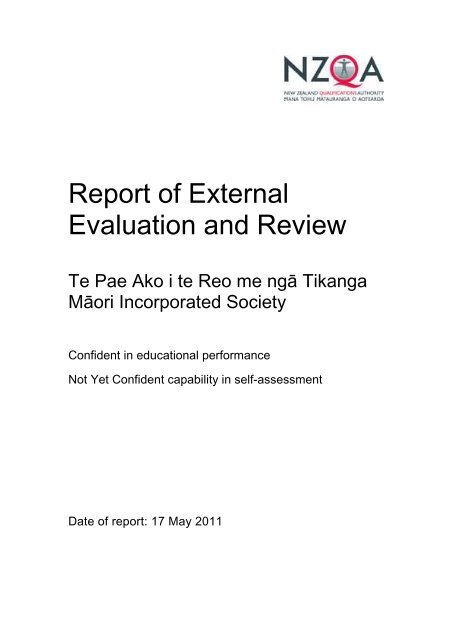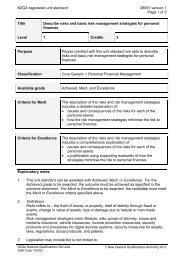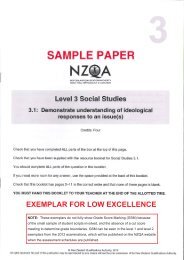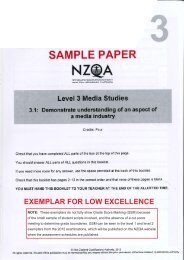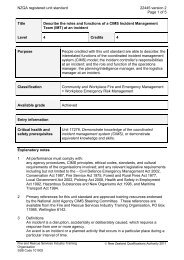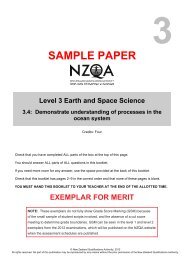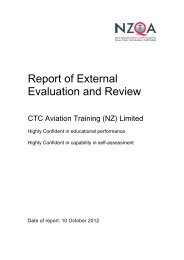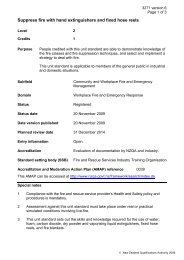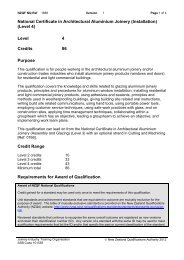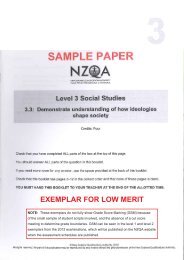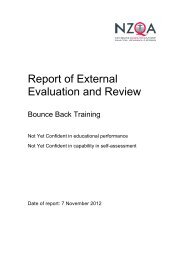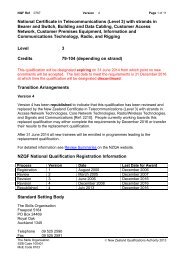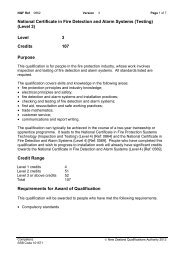Te Pae Ako i te Reo me nga Tikanga Maori Incorporated ... - NZQA
Te Pae Ako i te Reo me nga Tikanga Maori Incorporated ... - NZQA
Te Pae Ako i te Reo me nga Tikanga Maori Incorporated ... - NZQA
Create successful ePaper yourself
Turn your PDF publications into a flip-book with our unique Google optimized e-Paper software.
Report of Ex<strong>te</strong>rnal<br />
Evaluation and Review<br />
<strong>Te</strong> <strong>Pae</strong> <strong>Ako</strong> i <strong>te</strong> <strong>Reo</strong> <strong>me</strong> ngā Tika<strong>nga</strong><br />
Māori Incorpora<strong>te</strong>d Society<br />
Confident in educational performance<br />
Not Yet Confident capability in self-assess<strong>me</strong>nt<br />
Da<strong>te</strong> of report: 17 May 2011
Con<strong>te</strong>nts<br />
Purpose of this Report................................................................... 3<br />
Introduction ................................................................................... 3<br />
1. TEO in con<strong>te</strong>xt..........................................................................................3<br />
2. Scope of ex<strong>te</strong>rnal evaluation and review..................................................4<br />
3. Conduct of ex<strong>te</strong>rnal evaluation and review...............................................4<br />
Summary of Results ...................................................................... 6<br />
Findings ........................................................................................ 8<br />
Recom<strong>me</strong>ndations ...................................................................... 14<br />
Further actions ............................................................................ 14<br />
Appendix ..................................................................................... 15<br />
MoE Number: 9861<br />
<strong>NZQA</strong> Reference:<br />
C04101<br />
Da<strong>te</strong> of EER visit: 15 February 2011<br />
2
Purpose of this Report<br />
The purpose of this ex<strong>te</strong>rnal evaluation and review report is to provide a public sta<strong>te</strong><strong>me</strong>nt<br />
about the educational performance and capability in self-assess<strong>me</strong>nt of <strong>Te</strong> <strong>Pae</strong> <strong>Ako</strong> i <strong>te</strong> <strong>Reo</strong><br />
<strong>me</strong> ngā Tika<strong>nga</strong> Māori Incorpora<strong>te</strong>d Society (the Society). It forms part of the<br />
accountability process required by Govern<strong>me</strong>nt to inform investors, the public, students,<br />
prospective students, communities, employers, and other in<strong>te</strong>res<strong>te</strong>d parties. It is also<br />
in<strong>te</strong>nded to be used by the TEO itself for quality improve<strong>me</strong>nt purposes.<br />
Introduction<br />
1. TEO in con<strong>te</strong>xt<br />
Location:<br />
Type:<br />
6 Owen St, Napier<br />
Priva<strong>te</strong> Training Establish<strong>me</strong>nt<br />
First regis<strong>te</strong>red: 1995<br />
Number of students:<br />
Number of staff:<br />
Scope of active accreditation:<br />
Do<strong>me</strong>stic: for 2011 <strong>Te</strong> <strong>Pae</strong> <strong>Ako</strong> i <strong>te</strong> <strong>Reo</strong> <strong>me</strong> ngā<br />
Tika<strong>nga</strong> Māori Incorpora<strong>te</strong>d Society (the Society) has<br />
six <strong>Te</strong>rtiary Education Commission-funded Training<br />
Opportunities places, down from seven places in 2010<br />
and eleven places in 2009. Estima<strong>te</strong>d throughput is 200<br />
per cent, <strong>me</strong>aning that approxima<strong>te</strong>ly 12 funded<br />
learners may participa<strong>te</strong> in the program<strong>me</strong> during the<br />
year. In addition, the Society allows for up to three<br />
whānau enrol<strong>me</strong>nts for other learners who wish to join<br />
the initiative.<br />
In<strong>te</strong>rnational: nil<br />
1.5 full-ti<strong>me</strong> equivalents (comprising one full-ti<strong>me</strong><br />
chief executive/tutor and a Kaumātua tutor).<br />
<strong>Reo</strong> Māori unit standards to level 4 on the New Zealand<br />
Qualifications Fra<strong>me</strong>work.<br />
• <strong>Te</strong> Aho Wahine unit standards to level 2<br />
• Core Generic unit standards to level 2<br />
Si<strong>te</strong>s:<br />
Distinctive charac<strong>te</strong>ristics:<br />
One si<strong>te</strong>, within the <strong>Te</strong> Taiwhenua o <strong>te</strong> Wha<strong>nga</strong>nui a<br />
Orotu building.<br />
The provider offers one program<strong>me</strong>, <strong>Te</strong> <strong>Reo</strong> <strong>me</strong> ona<br />
Tika<strong>nga</strong> Māori, which is centred on Māori customs and<br />
language. This is a specialist program<strong>me</strong>, designed to<br />
3
<strong>te</strong>ach the language within the con<strong>te</strong>xt of its<br />
epis<strong>te</strong>mology (whakapapa). The effect is that the<br />
learning of the language is a vehicle for personal<br />
growth and the develop<strong>me</strong>nt of Māori cultural<br />
compe<strong>te</strong>ncy. The program<strong>me</strong> begins from ele<strong>me</strong>ntary<br />
<strong>te</strong> reo Māori and can progress up to level 4 if learners<br />
require, although for the majority, levels 1 and 2 are<br />
sufficient.<br />
Recent significant changes:<br />
Previous quality assurance<br />
history:<br />
Funding place<strong>me</strong>nt reductions from the <strong>Te</strong>rtiary<br />
Education Commission have significantly reduced the<br />
number of learners enrolled. The Society is aware that<br />
this may impact on its long-<strong>te</strong>rm viability.<br />
The Society was last quality assured by <strong>NZQA</strong> by audit<br />
in 2008. The audit found that the Society <strong>me</strong>t all but<br />
one require<strong>me</strong>nt of QA Standard One, the quality<br />
standard then in force. The require<strong>me</strong>nt not <strong>me</strong>t rela<strong>te</strong>d<br />
to physical and learning resources, specifically an<br />
expired building warrant of fitness. However, during<br />
this EER the evaluation <strong>te</strong>am sigh<strong>te</strong>d a current building<br />
warrant of fitness.<br />
2. Scope of ex<strong>te</strong>rnal evaluation and review<br />
The agreed scope of the ex<strong>te</strong>rnal evaluation and review was twofold:<br />
• Governance, manage<strong>me</strong>nt, and stra<strong>te</strong>gy<br />
• <strong>Te</strong> <strong>Reo</strong> <strong>me</strong> ona Tika<strong>nga</strong> Māori course.<br />
For this report, governance, manage<strong>me</strong>nt, and stra<strong>te</strong>gy was a mandatory focus area. <strong>Te</strong> <strong>Reo</strong><br />
<strong>me</strong> ona Tika<strong>nga</strong> Māori was selec<strong>te</strong>d as a focus area as it is the only program<strong>me</strong> offered by<br />
the Society.<br />
3. Conduct of ex<strong>te</strong>rnal evaluation and review<br />
All ex<strong>te</strong>rnal evaluation and reviews are conduc<strong>te</strong>d in accordance with <strong>NZQA</strong>’s published<br />
policies and procedures. The <strong>me</strong>thodology used is described fully in the docu<strong>me</strong>nt Policy<br />
and Guidelines for the Conduct of Ex<strong>te</strong>rnal Evaluation and Review available at:<br />
http://www.nzqa.govt.nz/providers-partners/registration-and-accreditation/ex<strong>te</strong>rnalevaluation-and-review/policy-and-guidelines-eer/introduction/<br />
The ex<strong>te</strong>rnal evaluation and review <strong>te</strong>am comprised an ex<strong>te</strong>rnal lead evaluator and a second<br />
ex<strong>te</strong>rnal evaluator. The <strong>te</strong>am visi<strong>te</strong>d the Society on 15 February 2011, and in a whānau hui<br />
<strong>me</strong>t with:<br />
4
• An iwi representative supportive of the Society (not a Society <strong>me</strong>mber)<br />
• A Ministry of Social Develop<strong>me</strong>nt employee (also a Society <strong>me</strong>mber)<br />
• Two for<strong>me</strong>r students (one now an employer of gradua<strong>te</strong>s)<br />
• Four current students (two of whom are student representatives on the Society)<br />
• Two society <strong>me</strong>mbers and kaumātua<br />
• The chief executive.<br />
In addition, the evaluation <strong>te</strong>am also <strong>me</strong>t separa<strong>te</strong>ly with the chief executive and contac<strong>te</strong>d<br />
(by <strong>te</strong>lephone) three ex<strong>te</strong>rnal people to triangula<strong>te</strong> evidence received through hui.<br />
<strong>Te</strong> <strong>Pae</strong> <strong>Ako</strong> i <strong>te</strong> <strong>Reo</strong> <strong>me</strong> ngā Tika<strong>nga</strong> Māori Incorpora<strong>te</strong>d Society has had an opportunity to<br />
com<strong>me</strong>nt on the accuracy of this report, and submissions received have been fully<br />
considered by <strong>NZQA</strong> before finalising the report.<br />
5
Summary of Results<br />
Sta<strong>te</strong><strong>me</strong>nt of confidence on educational performance<br />
<strong>NZQA</strong> is Confident in the educational performance of <strong>Te</strong> <strong>Pae</strong> <strong>Ako</strong> i <strong>te</strong> <strong>Reo</strong> <strong>me</strong> ngā<br />
Tika<strong>nga</strong> Māori Incorpora<strong>te</strong>d Society.<br />
The Society offers one program<strong>me</strong> of learning, <strong>Te</strong> <strong>Reo</strong> <strong>me</strong> ona Tika<strong>nga</strong> Māori, centred on<br />
Māori language and customs. This is a specialist program<strong>me</strong> designed to <strong>te</strong>ach the use of<br />
the language within the con<strong>te</strong>xt of its epis<strong>te</strong>mology (whakapapa) in a holistic manner. The<br />
program<strong>me</strong> begins from ele<strong>me</strong>ntary Māori language and can ex<strong>te</strong>nd up to level 4 on the<br />
New Zealand Qualifications Fra<strong>me</strong>work, although the significant majority of learners work<br />
at levels 1 and 2.<br />
The evaluation has found that learners are acquiring useful skills which contribu<strong>te</strong> to<br />
improved well-being. Evidential information that supports this conclusion was found in<br />
student evaluations of program<strong>me</strong>s, student in<strong>te</strong>rviews, and agency and employer feedback.<br />
This evaluation found evidence of strong stakeholder relationships between the Society and<br />
iwi, marae, kōha<strong>nga</strong> reo, and prominent Māori community leaders. The positive resulting<br />
influence of this approach was evident. For example, Ngāti Kahungunuta<strong>nga</strong> (local tribal<br />
custom) is embedded within the program<strong>me</strong>, and there is a demonstrable, strong focus on<br />
whakapapa and whakawhānau<strong>nga</strong>ta<strong>nga</strong> (kinship).<br />
The Society undertakes both goal-setting and needs assess<strong>me</strong>nt exercises for all students<br />
upon their com<strong>me</strong>nce<strong>me</strong>nt, to ensure there is a match between the learning experience<br />
offered and the desires of individual learners. The Society maintains an appropria<strong>te</strong> library<br />
of Māori language learning resources for students, and also develops its own ma<strong>te</strong>rials.<br />
There is a focus on “real-world” learning, whereby students practise their skills in<br />
community settings such as at tangi and hui. This approach demonstra<strong>te</strong>s a sound matching<br />
of the program<strong>me</strong> to learner and broader stakeholder needs.<br />
The program<strong>me</strong> offered by the Society follows a clear plan which identifies the resources<br />
required, the <strong>te</strong>aching approach, and desired learning outco<strong>me</strong>s. Tutors are highly<br />
knowledgeable in their subject areas and have comple<strong>me</strong>ntary delivery skills. Students<br />
indica<strong>te</strong>d that they found the delivery of program<strong>me</strong>s by educators to be of a high standard.<br />
Evidence sigh<strong>te</strong>d by the evaluation <strong>te</strong>am shows assess<strong>me</strong>nt processes are fair and consis<strong>te</strong>nt.<br />
The Society participa<strong>te</strong>s in moderation exercises as required. ‘ako’ – whereby educators<br />
also learn from students – is practised.<br />
There was limi<strong>te</strong>d evidence on the effectiveness of the governance of the Society, and in<br />
particular the role of <strong>me</strong>mbers in guiding and leading the organisation. There is a need for<br />
more active governance, as most of the leadership activity is falling on the chief executive,<br />
who is also the full-ti<strong>me</strong> tutor. This situation places the Society at so<strong>me</strong> risk of not<br />
achieving its purpose through the provision of Māori language.<br />
6
Sta<strong>te</strong><strong>me</strong>nt of confidence on capability in self-assess<strong>me</strong>nt<br />
<strong>NZQA</strong> is Not Yet Confident in the capability in self-assess<strong>me</strong>nt of <strong>Te</strong> <strong>Pae</strong> <strong>Ako</strong> i <strong>te</strong> <strong>Reo</strong><br />
<strong>me</strong> ngā Tika<strong>nga</strong> Māori Incorpora<strong>te</strong>d Society.<br />
The Society has not yet fully positioned itself to reflect on learner achieve<strong>me</strong>nts. Although<br />
student program<strong>me</strong> evaluations are undertaken, collation of this data and reporting of<br />
learning outco<strong>me</strong>s through to <strong>me</strong>mbers of the Society is not sys<strong>te</strong>matically occurring. The<br />
tracking of student outco<strong>me</strong>s, including formal qualification completions, is at an initial<br />
develop<strong>me</strong>nt stage, typically anecdotal in nature. The Society is not currently well<br />
positioned to de<strong>te</strong>rmine the proportion of students achieving its own level 1 or 2 certifica<strong>te</strong>s,<br />
and overall the Society was not aware of the educational/employ<strong>me</strong>nt outco<strong>me</strong>s of its<br />
learners af<strong>te</strong>r program<strong>me</strong> completions. Members acknowledge that self-assess<strong>me</strong>nt is not<br />
yet fully in<strong>te</strong>gra<strong>te</strong>d within the operational approach, and goals for the current academic year<br />
have yet to be finalised. There is, however, a comprehensive quality manage<strong>me</strong>nt<br />
docu<strong>me</strong>nt which is ready to be more actively applied (currently it does not guide the<br />
Society) when more fully developed.<br />
<strong>Te</strong>aching practices, such as formal appraisals, peer reviews, <strong>te</strong>aching observations, formal<br />
learner feedback, and other evaluative tools have yet to be imple<strong>me</strong>n<strong>te</strong>d as reflective<br />
practice tools and are undertaken for more regular compliance reasons.<br />
Regular Society <strong>me</strong>etings were not achieved in 2010, and possibly as a consequence of this,<br />
<strong>me</strong>mbers are not fully e<strong>nga</strong>ged in ensuring the success of the educational activities at<br />
present. There is a need for more active governance to improve self-assess<strong>me</strong>nt activities.<br />
7
Findings 1<br />
1.1 How well do learners achieve?<br />
The rating for performance in relation to this key evaluation question is Good.<br />
The rating for capability in self-assess<strong>me</strong>nt for this key evaluation question is Adequa<strong>te</strong>.<br />
The Society only offers one program<strong>me</strong>, centred on the Māori language and customs. This<br />
is a specialist program<strong>me</strong>, designed to <strong>te</strong>ach the philosophy of the language and the use of<br />
the language within the con<strong>te</strong>xt of its epis<strong>te</strong>mology (whakapapa). The program<strong>me</strong> begins<br />
from ele<strong>me</strong>ntary Māori language and can ex<strong>te</strong>nd up to level 4 certifica<strong>te</strong> on the New<br />
Zealand Qualifications Fra<strong>me</strong>work. However, the significant majority of learners are at<br />
levels 1 and 2 and receive a provider certifica<strong>te</strong> for their achieve<strong>me</strong>nts at this level.<br />
Kaumātua and Society <strong>me</strong>mbers outlined how the program<strong>me</strong> was designed to holistically<br />
improve the well-being of learners, to “uplift their mana”, and to assist people to develop<br />
their identity.<br />
In this con<strong>te</strong>xt, the evaluation has found that learners are acquiring useful skills which<br />
contribu<strong>te</strong> to their improved well-being. Evidential information that supports this<br />
conclusion was found in student evaluations of program<strong>me</strong>s (highly positive), in student<br />
in<strong>te</strong>rviews, from Ministry of Social Develop<strong>me</strong>nt feedback, and from employer com<strong>me</strong>nts.<br />
These information sources all confirm the positive impact of the program<strong>me</strong> on students as<br />
a significant life-changing experience. In addition, the language skills acquired had opened<br />
opportunities to employ<strong>me</strong>nt and further study for for<strong>me</strong>r students who were in<strong>te</strong>rviewed.<br />
In addition to personal develop<strong>me</strong>nt, the Society is contrac<strong>te</strong>d by the <strong>Te</strong>rtiary Education<br />
Commission to achieve particular occupancy and outco<strong>me</strong>s <strong>me</strong>asures. The chief executive<br />
<strong>me</strong>asures these on a monthly basis, and evidence sigh<strong>te</strong>d by the evaluation <strong>te</strong>am shows that<br />
funding targets are generally being <strong>me</strong>t. However, there is a more limi<strong>te</strong>d purview on the<br />
completion of formal qualifications, and the Society is not currently well positioned to<br />
de<strong>te</strong>rmine the proportion of students achieving its own level 1 or 2 certifica<strong>te</strong>s. The<br />
evaluation <strong>te</strong>am found that no student achieve<strong>me</strong>nt <strong>me</strong>asures (such as occupancy, credit<br />
upda<strong>te</strong>s) are being repor<strong>te</strong>d to the Society <strong>me</strong>mbers on a regular basis, with reflective<br />
practice being more anecdotal in nature. Overall, the Society was not aware of the<br />
educational/employ<strong>me</strong>nt outco<strong>me</strong>s of its learners af<strong>te</strong>r program<strong>me</strong> completions and<br />
acknowledged that self-assess<strong>me</strong>nt was yet to be fully in<strong>te</strong>gra<strong>te</strong>d within its operational<br />
approach.<br />
1 The findings in this report are derived using a standard process and are based on a targe<strong>te</strong>d sample of<br />
the organisation’s activities.<br />
8
1.2 What is the value of the outco<strong>me</strong>s for key stakeholders, including<br />
learners?<br />
The rating for performance in relation to this key evaluation question is Good.<br />
The rating for capability in self-assess<strong>me</strong>nt for this key evaluation question is Good.<br />
The Society is fully focused on Māori language learning as reflec<strong>te</strong>d in its mission<br />
sta<strong>te</strong><strong>me</strong>nt: “Ko <strong>te</strong> tumanako o <strong>te</strong> hine<strong>nga</strong>ro, kia mau tōnu to tātou reo Māori inanahi,<br />
inaianei, mo ake tōnu atu” (“It is our hope that the Māori language will remain s<strong>te</strong>adfast<br />
forever”). To achieve this mission the Society maintains a <strong>me</strong>mbership of people in the<br />
community connec<strong>te</strong>d to various organisations with a similar in<strong>te</strong>rest. These groups are<br />
defined as the stakeholders of the Society. Through the evaluation there was clear evidence<br />
of stakeholder relationships that the Society has developed and maintained, including with<br />
iwi leaders, marae, kōha<strong>nga</strong> reo, and prominent Māori community leaders. Having such<br />
people and groups involved as <strong>me</strong>mbers has assis<strong>te</strong>d the Society. For example, one positive<br />
resulting influence is that Ngāti Kahungunuta<strong>nga</strong> (local iwi custom) is embedded within the<br />
program<strong>me</strong>, and there is a demonstrable, strong focus on whakapapa and<br />
whakawhānau<strong>nga</strong>ta<strong>nga</strong> (kinship). The Society is also a <strong>me</strong>mber of the Association of<br />
Māori Providers of Training, Education and Employ<strong>me</strong>nt.<br />
A challenge for the Society, however, is to ensure <strong>me</strong>etings are held regularly to maintain<br />
these community connections. The Society may also need to consider more broadly its<br />
stakeholders to include other Māori language providers, to bet<strong>te</strong>r ensure connectivity with<br />
comple<strong>me</strong>ntary language provision available within the region. This is particularly<br />
important as the Society offers a foundation program<strong>me</strong>, and further learning in the<br />
language is a goal of many students.<br />
1.3 How well do program<strong>me</strong>s and activities match the needs of<br />
learners and other stakeholders?<br />
The rating for performance in relation to this key evaluation question is Good.<br />
The rating for capability in self-assess<strong>me</strong>nt for this key evaluation question is Adequa<strong>te</strong>.<br />
The Society undertakes both goal-setting and needs assess<strong>me</strong>nt exercises for all learners<br />
upon their com<strong>me</strong>nce<strong>me</strong>nt. This is to help ensure there is a match between the learning<br />
experience offered and the desires and charac<strong>te</strong>ristics of the individuals. Further, while the<br />
Society is conscious of the require<strong>me</strong>nt to enrol all people referred from the Ministry of<br />
Social Develop<strong>me</strong>nt, arrange<strong>me</strong>nts are in place for a one-week trial period, to ensure the<br />
social and education needs of individual learners can be ca<strong>te</strong>red for. If not, al<strong>te</strong>rnative<br />
provision will be found. Full checks of po<strong>te</strong>ntial students are undertaken through<br />
in<strong>te</strong>rviewing and case-manage<strong>me</strong>nt discussions before com<strong>me</strong>nce<strong>me</strong>nt. This is good<br />
practice.<br />
The Society maintains an appropria<strong>te</strong> library of Māori language learning resources for<br />
students and also develops its own ma<strong>te</strong>rials. There is a focus on “real-world” learning,<br />
whereby students practise their skills in community settings such as at tangi and hui. This<br />
9
approach demonstra<strong>te</strong>s a sound matching of the program<strong>me</strong> with learner and broader<br />
stakeholder needs.<br />
Self-assess<strong>me</strong>nt in this area is, however, not consis<strong>te</strong>ntly carried out, and the Society has<br />
yet to fully reflect on whether its traditional program<strong>me</strong> still <strong>me</strong>ets the needs of all students.<br />
Specifically, the Society has a unique challenge in that students may be required to leave<br />
the program<strong>me</strong> at any ti<strong>me</strong> if a work opportunity arises, and new learners may be placed<br />
within the program<strong>me</strong> by the funder. This <strong>me</strong>ans that running a single 46-week program<strong>me</strong><br />
is not necessarily best practice if average enrol<strong>me</strong>nts are now significantly shor<strong>te</strong>r. The<br />
Society will need to colla<strong>te</strong> enrol<strong>me</strong>nt data and look for trends to de<strong>te</strong>rmine whether its<br />
current program<strong>me</strong> is still maintaining high relevance, as currently this is only undertaken<br />
on an anecdotal basis.<br />
1.4 How effective is the <strong>te</strong>aching?<br />
The rating for performance in relation to this key evaluation question is Good.<br />
The rating for capability in self-assess<strong>me</strong>nt for this key evaluation question is Adequa<strong>te</strong>.<br />
The program<strong>me</strong> offered by the Society has a clearly writ<strong>te</strong>n plan which identifies the<br />
resources required, the <strong>te</strong>aching approach, and desired learning outco<strong>me</strong>s. Tutors are<br />
highly knowledgeable in their subject areas and have comple<strong>me</strong>ntary delivery skills. One<br />
of the two tutors has also comple<strong>te</strong>d qualifications in adult education (The National<br />
Certifica<strong>te</strong> in Adult Li<strong>te</strong>racy and Education). Students indica<strong>te</strong>d that they found the<br />
delivery of program<strong>me</strong>s by educators to be of a high standard, and which e<strong>nga</strong>ged them in<br />
learning in a safe and enjoyable way. Tutors observe a philosophy of accepting learners as<br />
they find them, and uplifting their mana. In relation to challenging learning situations, one<br />
com<strong>me</strong>nt received from a tutor was, “It is not the student that fails to learn, but the tutor<br />
that fails to <strong>te</strong>ach”.<br />
The evaluation <strong>te</strong>am sigh<strong>te</strong>d assess<strong>me</strong>nt processes that were fair and consis<strong>te</strong>nt. The<br />
Society participa<strong>te</strong>s in moderation exercises as required. “<strong>Ako</strong>” – whereby educators also<br />
learn from students – is practised. However, <strong>te</strong>aching appraisals, peer reviews, formal<br />
learner feedback, and other evaluative tools have yet to be well in<strong>te</strong>gra<strong>te</strong>d into the Society’s<br />
delivery model. These types of exercises appear to be undertaken casually or for<br />
compliance reasons rather than as opportunities for genuine professional growth and<br />
improved <strong>te</strong>aching effectiveness. Because the staffing base is small, there is a need for the<br />
Society to ensure staff have access to ex<strong>te</strong>rnal professional develop<strong>me</strong>nt opportunities<br />
relevant to the program<strong>me</strong> offered.<br />
10
1.5 How well are learners guided and suppor<strong>te</strong>d?<br />
The rating for performance in relation to this key evaluation question is Excellent.<br />
The rating for capability in self-assess<strong>me</strong>nt for this key evaluation question is Good.<br />
The Society consciously and delibera<strong>te</strong>ly arranges the delivery of its program<strong>me</strong> in a way<br />
that is supportive to learners and seeks to empower them to comple<strong>te</strong> the program<strong>me</strong> and<br />
consider further education or employ<strong>me</strong>nt opportunities. Foremost, the Society does this by<br />
drawing upon tika<strong>nga</strong> Māori approaches to guidance and support. This includes<br />
establishing whānau connectivity of learners with each other.<br />
The Society also structures its program<strong>me</strong>s around the other activities and needs of learners,<br />
including whānau and childcare commit<strong>me</strong>nts. The Society acknowledges that there can be<br />
a particular whakamā (sensitivity) experienced by so<strong>me</strong> learners, and focuses on<br />
highlighting successes rather than shortcomings. Evaluators observed that many students<br />
com<strong>me</strong>n<strong>te</strong>d on the positive āhuata<strong>nga</strong> (feeling) of the learning environ<strong>me</strong>nt. The Society’s<br />
approach is to build up the self-es<strong>te</strong>em of all learners, and it does this effectively through a<br />
supportive approach centred on whānau<strong>nga</strong>ta<strong>nga</strong> and manaakita<strong>nga</strong> (a sense of family and<br />
demonstra<strong>te</strong>d kindness). The Society is aware that so<strong>me</strong> learners present with social issues,<br />
and maintains relationship with support organisations to assist these learners.<br />
However, the Society has yet to self-assess on these initiatives and reflect fully on the type<br />
and frequency of issues arising that can crea<strong>te</strong> barriers to learning, including whether it is<br />
making an impact on the wider social concerns identified. A more comprehensive<br />
consideration would help ensure optimal outco<strong>me</strong>s for learners.<br />
1.6 How effective are governance and manage<strong>me</strong>nt in supporting<br />
educational achieve<strong>me</strong>nt?<br />
The rating for performance in relation to this key evaluation question is Adequa<strong>te</strong>.<br />
The rating for capability in self-assess<strong>me</strong>nt for this key evaluation question is Adequa<strong>te</strong>.<br />
The Society establishes annual goals in mid-March. This timing does not fully align with<br />
the academic year, which com<strong>me</strong>nces in la<strong>te</strong> January/early February. The goals do not<br />
clearly discuss achieve<strong>me</strong>nt of the mission sta<strong>te</strong><strong>me</strong>nt, or the key “cultural compe<strong>te</strong>ncy<br />
learning objectives” identified throughout in<strong>te</strong>rviews. Nor are qualification achieve<strong>me</strong>nt<br />
outco<strong>me</strong>s clearly established. Rather, the educational goals are orienta<strong>te</strong>d towards fulfilling<br />
contractual commit<strong>me</strong>nts, and there was little evidence that the results of these<br />
commit<strong>me</strong>nts were repor<strong>te</strong>d comprehensively to the Society.<br />
The Society has developed a full quality manage<strong>me</strong>nt sys<strong>te</strong>m, with a range of suitable<br />
policies and practices for managing enrol<strong>me</strong>nts, grievances, assess<strong>me</strong>nts, etc. However,<br />
there was little evidence that the sys<strong>te</strong>m is actively used to guide and advance best practice.<br />
There was also limi<strong>te</strong>d evidence on the effectiveness of the governance of the Society and,<br />
in particular, the role of <strong>me</strong>mbers in guiding and leading the organisation. Although there<br />
was a demonstra<strong>te</strong>d commit<strong>me</strong>nt by <strong>me</strong>mbers to the success and well-being of the<br />
organisation, this had not transla<strong>te</strong>d into active governance. Required <strong>me</strong>etings have not<br />
11
een achieved in 2010, and there is little recorded conversation on the educational success<br />
of learners or what program<strong>me</strong> develop<strong>me</strong>nts might be of most benefit to the community.<br />
There is a need for more active governance as most of the leadership activity is falling on<br />
the chief executive (who is also the full-ti<strong>me</strong> tutor). This situation places the Society at<br />
so<strong>me</strong> risk of not achieving its purpose. There may be a need for new <strong>me</strong>mbership of the<br />
Society to assist in this regard.<br />
12
Focus Areas<br />
This section reports significant findings in each focus area, not already covered in Part 1.<br />
2.1 Focus area: Governance, manage<strong>me</strong>nt, and stra<strong>te</strong>gy<br />
The rating in this focus area for educational performance is Good.<br />
The rating for capability in self-assess<strong>me</strong>nt for this focus area is Adequa<strong>te</strong>.<br />
2.2 Focus area: <strong>Te</strong> <strong>Reo</strong> <strong>me</strong> ona Tika<strong>nga</strong> Māori<br />
The rating in this focus area for educational performance is Good.<br />
The rating for capability in self-assess<strong>me</strong>nt for this focus area is Adequa<strong>te</strong>.<br />
13
Recom<strong>me</strong>ndations<br />
There are no recom<strong>me</strong>ndations arising from this ex<strong>te</strong>rnal evaluation and review, other than<br />
those implied or expressed within the report.<br />
Further actions<br />
Because <strong>NZQA</strong> is Not Yet Confident in the capability in self-assess<strong>me</strong>nt of <strong>Te</strong> <strong>Pae</strong> <strong>Ako</strong> i <strong>te</strong><br />
<strong>Reo</strong> <strong>me</strong> ngā Tika<strong>nga</strong> Māori Incorpora<strong>te</strong>d Society, <strong>NZQA</strong> will contact the Society to agree<br />
appropria<strong>te</strong> actions ai<strong>me</strong>d at the organisation achieving a level of at least Confident in<br />
capability in self-assess<strong>me</strong>nt.<br />
Progress toward improve<strong>me</strong>nt will be monitored by <strong>NZQA</strong> and a further EER scheduled at<br />
an appropria<strong>te</strong> ti<strong>me</strong>.<br />
14
Appendix<br />
Regulatory basis for ex<strong>te</strong>rnal evaluation and review<br />
Self-assess<strong>me</strong>nt and ex<strong>te</strong>rnal evaluation and review are require<strong>me</strong>nts of course approval<br />
and accreditation (under sections 258 and 259 of the Education Act 1989) for all TEOs that<br />
are entitled to apply. The require<strong>me</strong>nts are set through the course approval and<br />
accreditation cri<strong>te</strong>ria and policies established by <strong>NZQA</strong> under section 253(1)(d) and (e) of<br />
the Act.<br />
In addition, for regis<strong>te</strong>red priva<strong>te</strong> training establish<strong>me</strong>nts, the cri<strong>te</strong>ria and policies for their<br />
registration require self-assess<strong>me</strong>nt and ex<strong>te</strong>rnal evaluation and review at an<br />
organisational level in addition to the individual courses they own or provide. These<br />
cri<strong>te</strong>ria and policies are set by <strong>NZQA</strong> under section 253(1)(ca) of the Act.<br />
<strong>NZQA</strong> is responsible for ensuring TEOs continue to comply with the policies and cri<strong>te</strong>ria<br />
af<strong>te</strong>r the initial granting of approval and accreditation of courses and/or registration. The<br />
Institu<strong>te</strong>s of <strong>Te</strong>chnology and Poly<strong>te</strong>chnics Quality (ITP Quality) is responsible, under<br />
delega<strong>te</strong>d authority from <strong>NZQA</strong>, for compliance by the poly<strong>te</strong>chnic sector, and the New<br />
Zealand Vice-Chancellors’ Commit<strong>te</strong>e (NZVCC) has statutory responsibility for compliance<br />
by universities.<br />
This report reflects the findings and conclusions of the ex<strong>te</strong>rnal evaluation and review<br />
process, conduc<strong>te</strong>d according to the policies and cri<strong>te</strong>ria approved by the <strong>NZQA</strong> Board.<br />
The report identifies strengths and areas for improve<strong>me</strong>nt in <strong>te</strong>rms of the organisation’s<br />
educational performance and capability in self-assess<strong>me</strong>nt.<br />
Ex<strong>te</strong>rnal evaluation and review reports are one contributing piece of information in<br />
de<strong>te</strong>rmining future funding decisions where the organisation is a funded TEO subject to an<br />
invest<strong>me</strong>nt plan agreed with the <strong>Te</strong>rtiary Education Commission.<br />
Ex<strong>te</strong>rnal evaluation and review reports are public information and are available from the<br />
<strong>NZQA</strong> websi<strong>te</strong> (www.nzqa.govt.nz).<br />
Information relevant to the ex<strong>te</strong>rnal evaluation and review process, including the<br />
publication Policy and Guidelines for the Conduct of Ex<strong>te</strong>rnal Evaluation and Review, is<br />
available at: http://www.nzqa.govt.nz/for-providers/keydocs/index.html<br />
15
<strong>NZQA</strong><br />
Ph 0800 697 296<br />
E eeradmin@nzqa.govt.nz<br />
www.nzqa.govt.nz<br />
16


